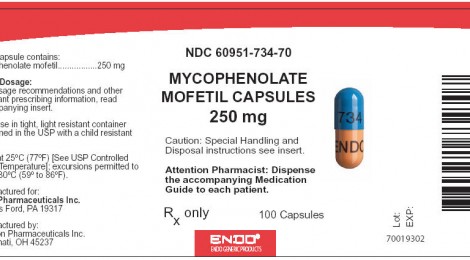
Advanced Stage IgAN Treatment With Mycophenolate Mofetil (MMF)
For many whose IgAN condition has progressed to a more advanced stage treatment options are limited and more the remaining treatments tend to be more difficult. The standard is to treat with steroids which has the effect of chemically suppressing the immune system but it comes with more than a few unpleasant side effects. More modern immune suppressants are also treatment candidate, one is mycofenelate mofetil.
Perhaps the most promising of all the modern immune suppressents is MMF, mycophenolate motetil. It’s used in treating transplant patients to reduce the chance of immune system rejection of the transplanted organ so it is well known to medicine. For IgAN patients if their disease progresses to the point of transplant then they will likely be put on MMF. Hence going on MMF to possibly prevent the need and complications of a kidney transplant seems like a good option.
Here’s a paper just out describing the effectiveness of MMF in treating IgAN. Good news is this is a free publication as well so if you are inclined you can read the full paper, or share it with your doctor.
Retrospective study of mycophenolate mofetil treatment in IgA nephropathy with proliferative pathological phenotype.
Author information
- 1Department of Nephrology, First Affiliated Hospital of Zhengzhou University, Research Institute of Nephrology, Zhengzhou University, Zhengzhou, Henan 450052, China.
- 2Department of Nephrology, First Affiliated Hospital of Zhengzhou University, Research Institute of Nephrology, Zhengzhou University, Zhengzhou, Henan 450052, China. Email: zhangsuoliu@sina.com.
Abstract
BACKGROUND:
Mycophenolate mofetil (MMF) and cyclophosphamide (CTX) are widely used in treating various kidney diseases. However, whether they are effective and which one is better for treating IgA nephropathy patients with proliferative pathological phenotype in renal diseases, such as endocapillary proliferation, cellular crescents, and/or capillary loops fibrinoid necrosis is still unknown. We, therefore, initiated a study to compare the effects of MMF and CTX in treating IgA nephropathy with the above pathological lesions.
METHODS:
One hundred and nineteen patients with IgA nephropathy who had at least one of the three aforementioned lesions were enrolled. All patients were treated with prednisone; 48 patients received prednisone only (Pred group), 40 received MMF and prednisone (MMF + Pred group), and 31 were treated with CTX and prednisone (CTX + Pred group). The median time of follow-up was 30 months (maximum: 96 months). The primary endpoint was defined as renal survival. The incidence of remission of proteinuria was the secondary endpoint.
RESULTS:
Serum creatinine in all groups declined significantly at different follow-up times (P = 0.002), and the differences among the three groups were significant (P < 0.001). At 24 months of follow-up, the decline rates were 12.35%, 32.95%, and 24.14% in the Pred, MMF + Pred, and CTX + Pred groups respectively. For urine protein excretion, the decline rates were 49.12% (Pred), 73.67% (MMF + Pred), and 63.53% (CTX + Pred) respectively at 24 months of follow-up. The differences among the three groups were not significant (P = 0.714). Renal survival (the primary endpoint) was significantly different (P = 0.027); however, the sencondary endpoint was similar for all the three groups (P = 0.100).
CONCLUSIONS:
For IgA nephropathy patients with endocapillary proliferation, cellular crescents, and/or fibrinoid necrosis of capillary loops, prednisone combined with MMF was more effective in lowering the serum creatinine than with CTX. Combined MMF and prednisone treatment led to a better renal survival compared to that of prednisone with CTX.
- PMID:
- 24384432
- [PubMed – in process]
Free full text
Recent Comments